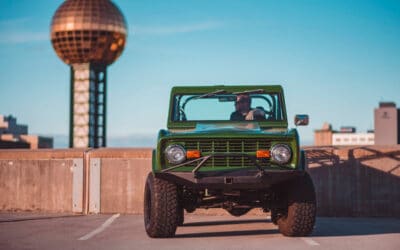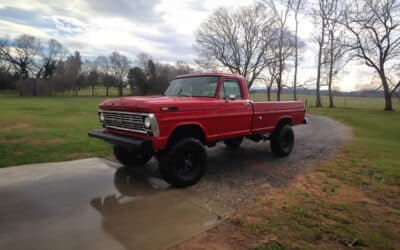Vintage cars are more than just modes of transportation; they are rolling pieces of art, epitomizing elegance, craftsmanship, and the spirit of past eras. Photographing these automotive beauties is not just about snapping pictures; it’s about capturing their essence and preserving their legacy.
This guide will walk you through the key aspects of vintage car photography, from preparation and lighting to the final touches in post-production, and how to find the right photographer for your classic vehicle.

Table of Contents
Preparation and Equipment
Before going into the specifics of capturing the timeless beauty of vintage cars, it’s important to understand the fundamentals. This section will cover the essential groundwork needed for successful vintage car photography.
Ideal Times and Locations for Classic Car Photography
Timing is crucial in photography, and it’s no different for vintage cars. The soft, warm light of early mornings and late afternoons can significantly enhance the car’s curves and colors. Choosing a location that complements your car can also make a big difference.
Scenic landscapes, historic buildings, or even urban settings that echo the car’s era can serve as perfect backdrops, adding context and depth to your photographs.
Cleaning and Polishing Car Before Photos
Before you even take out your camera, make sure your vintage car is in pristine condition. A thorough cleaning and polishing not only make the car look its best but also help reflect light, adding to the vibrancy and appeal of your images.
Pay special attention to details like chrome accents, hubcaps, and mirrors, as these elements can catch the light and really make your photos pop whether you’re looking to sell your car or truck or just have some awesome art to display.
Equipment Recommendations
While smartphones have come a long way, nothing beats a DSLR or a high-quality mirrorless camera when it comes to serious photography. These cameras offer greater control over settings like aperture, shutter speed, and ISO, allowing you to capture the car in the best possible light. A tripod is invaluable, especially for steady shots in low-light conditions or for long-exposure photography that can capture the motion and energy of the car.
In the following sections, we’ll delve deeper into aspects like lighting, composition, and post-production, ensuring that you have all the information you need to beautifully photograph your vintage car. Additionally, we’ll explore how to find and assess the right photographer who can bring out the true character of your classic vehicle.

Using a Vintage Camera for Classic Cars Photography
Using a vintage camera for photographing classic cars can add a unique and authentic feel to your images. These cameras, with their distinct characteristics and imperfections, often produce photos with a nostalgic and timeless quality.
The grain, color rendition, and lens aberrations of vintage cameras can complement the classic nature of the vehicles, enhancing the overall aesthetic of your photographs.
While using such cameras may require a more manual and thoughtful approach compared to modern digital cameras, the results can be deeply rewarding, capturing the essence of the vintage era in a way that modern technology sometimes cannot replicate.
Like why we think old trucks are better than new ones.
Mastering the Art of Lighting and Filters
In vintage car photography, lighting can make or break your photos. This section focuses on mastering the use of natural light and filters to bring out the best in your classic vehicle.
Utilizing Natural Light for Optimal Results
Natural light, especially during the golden hours after sunrise and before sunset, provides a soft, warm glow that accentuates the car’s features. Positioning the car to maximize the use of this light can dramatically enhance the quality of your photos.
Implementing Polarizer Filters to Enhance Images
Polarizer filters are a key tool in reducing reflections, particularly from the car’s glossy surfaces. They also help in saturating colors and the sky, making your vehicle stand out more vividly in the photographs.
Composition and Perspective
Capturing vintage cars is about more than just pointing and shooting; it’s about finding the right angles and perspectives to showcase their unique beauty.

Exploring Various Angles and Perspectives
Experiment with different shooting angles to highlight various aspects of the car. Whether it’s a full profile shot or a close-up of the emblem, each angle offers a different perspective and tells a different story.
Mastering Depth of Field for Impactful Images
Controlling the depth of field is crucial in emphasizing specific features of the car while artistically blurring the background. Adjusting the aperture allows you to decide how much of your image is in sharp focus, helping to draw attention to the car’s most captivating aspects.
Focusing on the Details
Vintage cars are renowned for their intricate details and craftsmanship. This section explores how to capture these elements to tell a more compelling story about the vehicle.
Close-Up Shots of Distinctive Features
Highlighting details like hood ornaments, intricate grilles, and classic wheel designs is key. Using macro lenses for these shots can reveal the textures and craftsmanship that define the car’s character.
Interior Detail Photography
The interior of a vintage car often contains elements of historical and artistic significance and is a point of pride in many restorations. Focus on the dashboard, steering wheel, and upholstery, ensuring enough light to bring out the best in these details.

Capturing Action and Movement
Vintage cars aren’t just static showpieces; they’re also symbols of speed and elegance. This section covers how to capture these vehicles in motion, adding a dynamic element to your photography.
Panning Shots for a Sense of Speed
Panning photography is a technique where the camera moves along with the car, creating a sharp subject against a blurred background. This conveys a sense of movement and speed, making the car appear as if it’s racing.
Easy to do if you use your classic as a daily driver.
Utilizing Long Exposure for Dynamic Shots
Long exposure shots can effectively capture the motion of a car, especially in low-light conditions. This technique creates a sense of speed and drama, bringing a dynamic quality to the image.
Post-Production and Editing
Enhancing The Image of Vintage Cars with Post-Processing Techniques
The art of vintage car photography doesn’t end with the click of the shutter; post-production plays a crucial role in refining and enhancing the final images.
Adjusting Contrast, Saturation, and Sharpness
In post-production, adjusting elements like contrast, saturation, and sharpness can significantly improve the visual impact of the photos. These adjustments can bring out the vibrant colors and intricate details of the cars, making them more striking.
Experimenting with Vintage Filters and Black-and-White Conversions In Photographs
To add a nostalgic touch, experimenting with vintage filters or converting images to black-and-white can be effective. These editing techniques can evoke the era of the car, aligning the photo’s aesthetic with its historical context.
Post-processing is an essential step in transforming a good photograph into a great one. It allows the photographer to fine-tune the image to match the vision they had when taking the shot, ensuring that the final result does justice to the timeless beauty of vintage cars.
Telling a Story Through Your Photos
Photographing vintage cars is not just about capturing images; it’s about telling a story and evoking emotions connected to the era of the vehicle.
Incorporating Era-Specific Elements
To create a narrative, consider incorporating props or backgrounds that reflect the car’s era. This could include vintage gas stations, period-correct accessories, or even clothing styles in the photos.
These elements can add depth and context, making the photos more than just pictures of cars, but a window into a different time and vintage cars are especially popular for wedding cars.
Showcasing Cars in Their Natural Environment
Presenting the car in settings that match its history or design can be very effective. Whether it’s cruising down a scenic road or displayed at a classic car gathering, the environment can play a significant role in telling the car’s story.
By focusing on the narrative aspect, your photography can celebrate not just the car’s design and engineering, but also the history and culture that it represents.

Sharing and Celebrating Your Vintage Car Photography
After capturing the beauty of vintage cars through photography, sharing your work with others can be just as rewarding as the process of taking the photos.
Social Media and Automotive Forums
Platforms like Instagram, Facebook, and specialized automotive forums are great places to share your photos. They allow you to connect with a community of like-minded enthusiasts who appreciate the artistry of vintage cars.
Sharing your work on these platforms can also provide valuable feedback and foster connections.
Creating Albums and Photo Books
Consider compiling your photos into albums or creating a coffee table book. These collections can serve as a personal keepsake or a unique gift for fellow car enthusiasts.
They offer a tangible way to appreciate the art of vintage car photography and celebrate the timeless beauty of these classic vehicles.
Sharing your work not only celebrates the charm of vintage cars but also helps keep the history and culture they represent alive for future generations.
Finding Skilled Photographers for Vintage Car Photography
Finding a photographer skilled in vintage car photography is essential for capturing the essence of these classic vehicles.
Utilizing Online Platforms and Professional Organizations
Explore photography platforms and websites, and consider photographers affiliated with professional organizations. These sources often showcase portfolios and credentials, helping you identify photographers with the right aesthetic and technical skills.
Leveraging Social Media and Local Clubs
Social media platforms, especially Instagram and LinkedIn, are valuable for finding photographers. Photography clubs and local events can also offer leads to talented individuals.
Assessing a Photographer’s Expertise
It’s crucial to assess the photographer’s expertise to ensure they can effectively capture the spirit of your vintage car.
Reviewing Portfolios and Checking References
Examine the photographer’s portfolio for style and quality, and don’t hesitate to check references or online reviews for feedback on their work.
Evaluating Technical Knowledge and Professionalism
Discuss their approach to lighting, composition, and equipment use. Assess their communication skills and professionalism to ensure they align with your vision.
Joseph Nother’s Bespoke Car Photography
Joseph Nother specializes in photographing both vintage and modern cars, treating them as art forms.
Bespoke Sessions and Fine Art Photography
Nother offers bespoke photo sessions and limited edition fine art photography, utilizing specific lighting and compositing techniques to highlight the features of these vehicles.
Emphasizing Design and Advertising Expertise
His work reflects a deep understanding of design and advertising, showcasing his passion and lifelong love for cars.
For more about Joseph Nother’s work, visit Art of the Auto.



